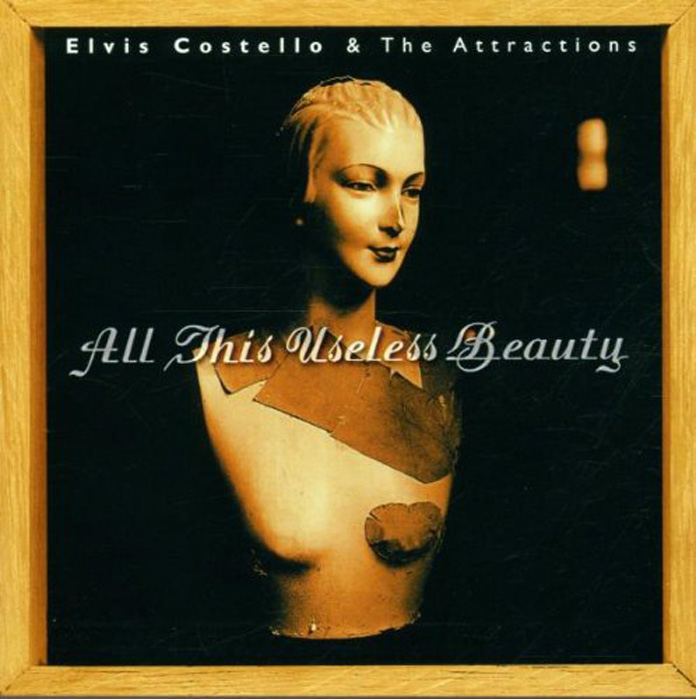
Elvis Costello & The Attractions – Reflecting on the 25th Anniversary of “All This Useless Beauty”
The Album Came Out May 14, 1996 via Warner Bros.
On the 25th anniversary of the last album that Elvis Costello has recorded to date with his legendary backing group The Attractions, it’s worth going back to look at how it’s aged. The answer, as is the case with most of his records, is very good and perhaps better than expected. Why? Well, let’s look at the circumstances surrounding its release. In the mid ’90s, Costello was riding high on the impact of 1994’s Brutal Youth, an album that was very successful in the UK, producing hit singles and peaking at #2 on the charts there.
Following a few stop-gap releases in 1995 (respectively, the covers album Kojak Variety, recorded much earlier with different musicians, and Deep Dead Blue, a gorgeous live mini-album from the 1995 Meltdown festival in London that Costello also curated, it features stripped-down versions of Costello deep cuts and a few covers with Costello on vocals only accompanied by Bill Frisell’s guitar), All This Useless Beauty was highly anticipated and many fans who fell hard for the late ’70s/early ’80s nostalgia hinted at on about half of Brutal Youth were initially disappointed. I recall hearing complaints that his lead electric guitar (a huge presence on his records with the Attractions since 1986’s Blood and Chocolate) doesn’t even show up until the fourth track, a tune intended for Johnny Cash but not recorded by him called “Complicated Shadows.”
And that brings up another important point about this record. It was also criticized since many of its songs were originally written for and recorded by other artists. Somewhat remarkably, this fact doesn’t diminish the power of Costello’s own versions or the flow and consistency of the record, either. These songs aren’t castoffs, but prime material from one of the finest lyricists and songwriters of the last 45 years, if not of all-time. Opener “The Other End of the Telescope” differs sharply from the Til Tuesday version (on 1988’s Everything Different Now, their last album) both lyrically and in Costello’s vocal power, sometimes derided as an operatic bellow, which works to beautiful effect here.
Elsewhere, “Little Atoms” has an instrumental refrain not dissimilar to the German national anthem and keyboard effects from the inimitable Steve Nieve are unusually dated-sounding on that track, this time recalling Windows operating system log-in noises from that time period, not the DX7 programming of 1984’s underrated Goodbye Cruel World. This is also, somewhat notably, the last time that a McCartney/MacManus collaboration showed up on one of Costello’s records with the song in question being “Shallow Grave,” a better produced take on the very similar McCartney/MacManus composition “Pads, Paws, and Claws” from 1989’s Spike.
Despite having a decent number of rockers, a good chunk of the album consists of ballads that primarily feature Costello’s vocals and Nieve’s piano playing. This is showcased most memorably on the stunning title track (first recorded by June Tabor), the just as stunning “Poor Fractured Atlas” and the show-stopping “I Want to Vanish,” a memorable album closer for the ages. Elsewhere, we get Costello’s version of the Byrds-ish “You Bowed Down” (recorded by The Byrds’ own Roger McGuinn on his 1990 album Back from Rio) and a stunning soul ballad called “Why Can’t a Man Stand Alone” that Sam Moore (of Sam and Dave) somehow rejected. The coda of it and the notes Costello hits when he yells “stand up” are jaw-dropping and goosebump-inducing and is perhaps the most stunning moment on a record full of them.
Overall, All This Useless Beauty should be rightfully considered as one of Costello’s best later-day albums and as his final album for Warner Brothers, it nicely previewed not only where he would go with 1998’s Painted from Memory (his brilliant collaboration with Burt Bacharach and his Universal debut), but the hundreds of shows he and Steve Nieve would play in the ensuing years as a piano and vocal duo, stunning audiences by delving deeper into his formidable back catalog than he ever had before that in his live shows. This lasted regularly until his next permanent band (The Imposters, who have backed him since 2001 and who are comprised of two of the three former Attractions, namely Nieve and drummer Pete Thomas, with Davey Farragher replacing the unrelated Bruce Thomas on bass) was assembled and after that, the Costello/Nieve shows became much less frequent by the early ’00s.
Support Under the Radar on Patreon.
Current Issue

Issue #72
Apr 19, 2024 Issue #72 - The ‘90s Issue with The Cardigans and Thurston Moore
Most Recent
- Bat For Lashes Shares a Cover of Baauer’s “Home” From Her New Album (News) — Bat For Lashes, Baauer
- Premiere: Veronica Lewis Shares New Single “Disconnected” (News) — Veronica Lewis
- The Decemberists Share New Song “All I Want Is You” (News) — The Decemberists
- Ella McRobb Releases New Single “Slow Motion Heartbreak” (News) — Ella McRobb
- Light Verse (Review) — Iron & Wine

Comments
Submit your comment
There are no comments for this entry yet.